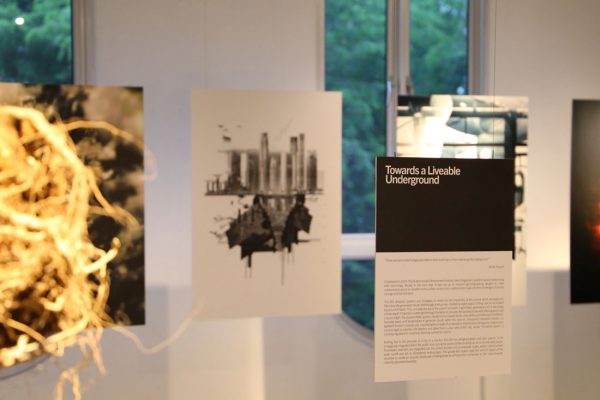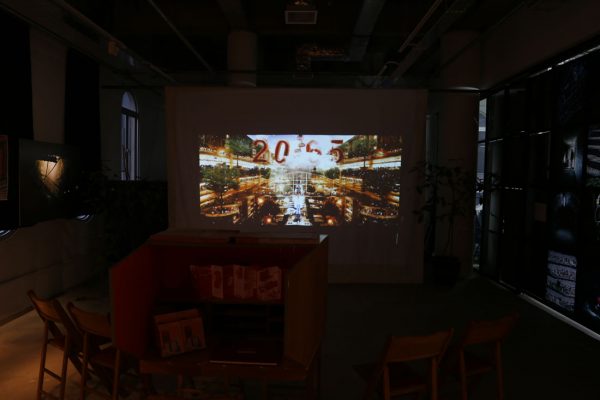What will happen if Singapore can no longer build sideways or up? Is going underground an option? An exhibition hosted by Zarch Collaboratives brought together facts and speculative fiction in a fascinating discussion.

Image by Finbarr Fallon
November 9th, 2017
The year is 2065. Singapore has excavated a massive underground cavern and built a complex ‘master section’ comprising steel superframes, modular structures, inflatable mechanical lungs and continuously expanding networks of canyons and tunnels to house its population.
In celebration of SG100, an engineer from the Subterranean Development Institute – a government body founded in 2020 – takes us through the history of the subterranean Singapore and shows a glimpse of life underground.

This is the premise of Subterranean Singapore 2065, a short film created by Bartlett Architecture graduate Finbarr Fallon for his MArch thesis. The seven-minute reel combines live footage, CGI, photography and animation. Fallon practices at the intersection of art and architecture and specialises in creating visions of the built environment. He relocated to Singapore in 2016 to join Zarch Collaboratives.
The film became the source material of Subterranean Singapore, an exhibition held in October at the workshop space within Zarch’s Golden Mile Tower studio as part of Archifest 2017. The exhibition included a discussion session with panellists Fallon, Zarch founder Randy Chan, and artist Charles Lim Yi Yong about the underground as Singapore’s next frontier.

“It’s research into this idea of spatial production,” said Chan of the programme. “We’ve always been told that land is scarce in Singapore. We build up, and we do land reclamation. I wonder if there’s a limit and if we should look at other ways of producing space.”
Fallon took inspiration for his film from, among others, the works of Jules Verne and the contrast of Singapore’s architectural landscapes he found during his decade-apart visits to the country in 1997 and the late noughties.
Providing a fascinating contrast to Fallon’s speculative fiction were facts compiled and documented by Lim in his Sea State series. A Central Saint Martins graduate and a former professional sailor who competed for Singapore in the 1996 Olympic Games, Lim is well-versed in Singapore’s effort to conquer the seas around it. The Sea State series is an extensive and ongoing project that examines Singapore’s identity as an island nation and its relationship with the sea.

So, is going underground a viable way to produce space? Chan, Fallon and Lim agreed that it could be an option in the future. Chan floated the idea of possibly using the excavated materials for reclamation, since Indonesia – in light of losing seven of its islands – has banned sand export to Singapore.
Lim shared that since Singapore has already been using the Jurong Rock Caverns to store its oil reserves, this scenario could very well have been thought of. “Maybe it’s written somewhere already,” he said, sharing with the audience the existence of the Centre for Strategic Futures – a strategy group under the Prime Minister’s office whose primary jobs include speculating all the “what if scenarios”.
“You should show this movie to them,” said Chan to Fallon. Fallon revealed that he had shown it to a government agency. “They were interested, but a bit disturbed by the ending,” he admitted, referring to a plot twist at the conclusion of the film that serves as a caveat, of sorts. Subterranean Singapore 2065 can be viewed at Fallon’s website.
INDESIGN is on instagram
Follow @indesignlive
A searchable and comprehensive guide for specifying leading products and their suppliers
Keep up to date with the latest and greatest from our industry BFF's!

For Aidan Mawhinney, the secret ingredient to Living Edge’s success “comes down to people, product and place.” As the brand celebrates a significant 25-year milestone, it’s that commitment to authentic, sustainable design – and the people behind it all – that continues to anchor its legacy.

A curated exhibition in Frederiksstaden captures the spirit of Australian design

Welcomed to the Australian design scene in 2024, Kokuyo is set to redefine collaboration, bringing its unique blend of colour and function to individuals and corporations, designed to be used Any Way!

London-based design duo Raw Edges have joined forces with Established & Sons and Tongue & Groove to introduce Wall to Wall – a hand-stained, “living collection” that transforms parquet flooring into a canvas of colour, pattern, and possibility.
The internet never sleeps! Here's the stuff you might have missed

The New York headquarters of haircare brand, Amika, has been designed by Civilian as the antithesis of a standard business hub.

Founded by Ana Ćalić McLean and Josh McLean, In Addition is a design studio creating thoughtful, client-focused architecture and interiors.

Adam Markowitz Design, in collaboration with Simeon Dux, has been awarded The Object at the INDE.Awards 2025. Their winning project, A Cabinet of Curiosities, is a masterwork of craftsmanship and adaptability; a poetic response to shifting domestic and professional life in the post-COVID era.